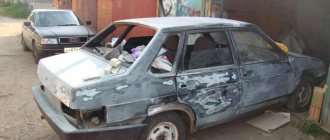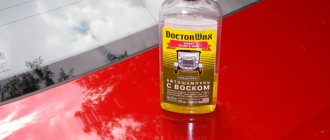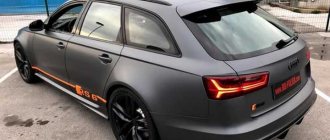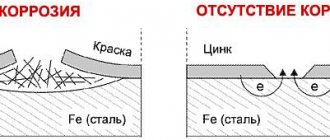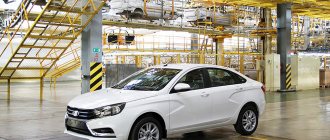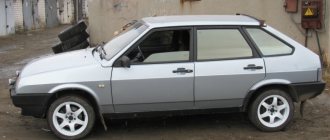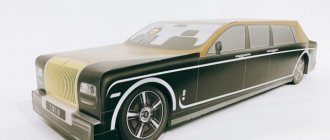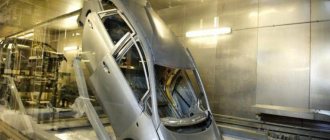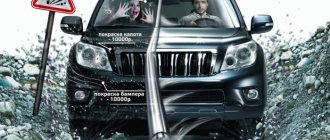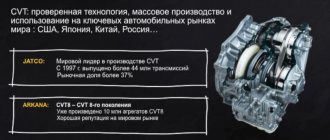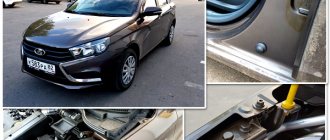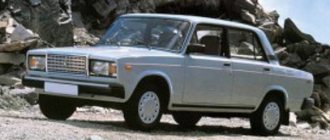Welcome to the Kuzov.info blog!
In this article we will talk about the monocoque body of the car, the history of its appearance, its characteristics and structure.
The monocoque body replaced the frame structure of the car. Roughly speaking, it combines the frame and body into one and has additional reinforcements in the necessary places. The frame is replaced by longitudinal (spars) and transverse load-bearing elements.
Some vehicles, such as trucks and some SUVs, still have body-on-frame construction.
The monocoque body has a similar principle and design, which was used for years in the aircraft industry even before it appeared in cars.
The history of the appearance of the load-bearing body structure
The first attempt to create a monocoque body was made in 1922. The Lancia Lambda was created. It had no roof and was more like a frame with built-in side elements. The American company Budd Company played a key role in the development of the monocoque body, which supplied automakers Dodge, Ford, Buick and Citroën with equipment for pressing sheet steel. In 1930, Austrian engineer Joseph Ledwinka, together with the Budd company, created a prototype of a monocoque body, which he immediately patented.
Load-bearing body of the Citroen Traction Avant
Citroen released the first car with a monocoque body, the Citroen Traction Avant. This car had a full-fledged monocoque body with all the power elements that are used on modern cars. As in the manufacture of modern monocoque bodies, resistance welding was used to connect body elements. Its mass production began in 1934. Subsequently, this body design gradually began to replace the traditional frame structure.
Device
Despite the variety of layouts, the car body has common elements. They are shown in the figure below and include:
- Front and rear side members. They are rectangular beams that provide structural rigidity and vibration damping.
- Front shield. Separates the engine compartment from the passenger compartment.
- Front pillars. They also provide rigidity and secure the roof.
- Roof.
- Rear pillar.
- Rear wing.
- Luggage panel.
- Middle post. Provides body rigidity and is made of durable sheet steel.
- Thresholds.
- The central tunnel where various elements are located (exhaust pipe, driveshaft, etc.). Also increases rigidity.
- Base or bottom.
- Wheel niche.
Detailed structure of the car body
The design may be different depending on the type of body (sedan, station wagon, minibus, etc.). Particular attention in the design is paid to load-bearing elements such as spars and struts.
Characteristics of the monocoque body
The body structure is made from a combination of pressed sheet panels of different shapes, connected into a single structure using resistance spot welding. The body is relatively light and very durable.
This type of construction is often compared to an egg shell. If you try to crush an egg, applying force longitudinally, from opposite ends, it will not be easy to do. This happens due to the fact that all the force is not concentrated in one place, but is dispersed throughout the entire shell. The load-bearing body functions in a similar way. In frame cars, which existed before the advent of monocoque bodies, the frame took on all the loads, and the body provided only functional needs. In a monocoque body, the power elements are part of the body, which, in turn, consists of many panels welded to each other and forming a single structure. Even glued car windows (windshield and rear) affect the overall rigidity. Thus, the load is distributed throughout the body.
Thanks to the absence of a frame, automakers were able to make cars more compact and lighter, and there was also greater freedom in design.
The disadvantages of a monocoque body include noise and vibration, which is more transmitted to the body than on a frame car. In modern cars, this problem is solved through the use of noise-vibration insulating materials.
The monocoque bodies use fairly thin sheet metal, the strength of which is increased by stamping. Power elements are made of high-strength steel. In these types of bodies, rust can affect the structural rigidity of the body and safety. Therefore, anti-corrosion protection, especially of structural elements, is very important.
The monocoque body gives the advantage of a lower center of gravity of the vehicle, increasing economy and safety ratings. A lower center of gravity improves stability and handling and reduces the likelihood of a vehicle rollover.
Crash tests were repeatedly carried out with cars with a frame structure and cars with a monocoque body. Cars with a monocoque body show better safety in frontal crashes and rollovers, but slightly worse safety in side crashes.
Let's look at the design of the supporting body, dividing it into three parts: front, central and rear.
Conclusion
There are now many more models with a monocoque body on the automobile market. This design is more popular than the frame one, despite the obvious disadvantages. The main reason why frameless construction is popular is increased passive safety (heavy-duty steel, planned compression zones).
But even if we ignore the main reason, in many situations a monocoque body actually turns out to be an appropriate solution. Suitable for mass production, creating classic passenger cars. For fast, comfortable driving on city roads. Not suitable for off-road enthusiasts, for premium class enthusiasts (premium passenger cars are built on a frame).
Front body design
- The main power elements of the front part of the load-bearing body are the side members. These are longitudinal hollow elements attached closer to the bottom of the front part of the body. They are the strongest elements of the load-bearing body of a car. They are made of high strength steel. The spars are attached partially to the engine compartment shield and partially to the bottom of the front mudguards of the body. The spars have zones of planned collapse during accidents to absorb energy during a frontal impact.
- Front fender aprons (mud flaps) are internal panels that fit around the wheel and protect from dirt. They are partially welded to the side members. Mud flaps also add structural rigidity to the body.
- The upper mudguard reinforcement is a structural element of the front part of the body. The front fenders are screwed onto it.
- Body cups are reinforced body parts that support the top of the suspension struts. They are formed as part of the body mud flaps.
- The radiator frame (radiator support, engine compartment frame) is a structural element located in the front part of the body and holds the cooling system radiator, hood latch and other adjacent elements of the car. The radiator frame is attached to the side members and mudguards. It stiffens the front part of the body as a transverse structural element.
- The engine compartment shield (or front bulkhead) is a panel dividing the front section of the body and the central section of the cabin. The engine compartment shield helps protect the driver and passengers in the event of a fire in the engine compartment. Behind the shield is a power structure that protects the driver and passengers at the time of an accident.
- The front fenders are located next to the front doors and extend to the front bumper. They cover the front suspension and the front mudguards. On modern cars, the fenders are usually bolted to the body.
- The bumper reinforcement is screwed to the front of the side members and is designed to absorb the impact in an accident.
Central part of the supporting body
- The floor pan is the main structural section of the lower part of the vehicle's interior. Often, the bottom is stamped as one large solid panel. Longitudinal and transverse load-bearing elements pass from the underside of the body bottom. The seat mounting points are reinforced and also stiffen the bottom.
A cross-section of the instrument panel shows reinforcement that increases the safety of the interior in the event of an accident.
- The central part of the body (salon) is surrounded by reinforced panels for the safety of the driver and passengers. The side central pillar has reinforcement inside, the doors have reinforcements inside and are themselves a fairly strong structure, there is a reinforced structure behind the instrument panel, the roof usually has a reinforced cross member that saves the interior during a rollover.
- Body pillars are vertical elements that support the roof structure and protect the interior of the body in the event of a vehicle rollover. The body pillars consist of external face parts and internal reinforcement made of high-strength steel. In the sedan body structure there are 3 types of body pillars (front, middle or side and rear pillars, which go into the rear fenders). The A-pillars extend into the windshield frame. B-pillars support the roof structure between the front and rear doors. They help strengthen the roof and provide mounting points for the rear door hinges. B-pillars distribute loads from the lower to the upper parts of the body and prevent compression of the side parts during side impacts, protecting the interior of the body. The C-pillars support the rear portion of the roof and extend into the rear fenders. They are also a seat for the rear window.
- The side panel is a common design in which the front and rear door openings are made of one element, without welding parts. This device provides the advantage of less susceptibility to corrosion.
- Thresholds are reinforced structures that are located at the bottom of doorways. They are connected by resistance welding to the bottom flanges. Reinforcement is located inside the front part of the thresholds. The sills support the lower part of the B-pillars and serve as lateral support for the underbody.
- The rear “shelf” is a panel located behind the rear seats, under the rear window.
- The rear partition separates the interior of the body and the luggage compartment (on sedans).
- The doors have a composite structure. They consist of an outer panel, an internal reinforcement and a part on which the window regulators and other door elements, including the trim, are attached.
- The roof panel covers the central part of the body and is supported by the body pillars. The roof panel is one of the largest panels of the body and, at the same time, is a very simple structure. The rigidity of the roof is given by its shape, as well as by reinforcements that are located on the reverse side and glued to it. The roof, which goes into the rear wing, is welded using brass or silicon bronze. This type of connection allows you to make a long, even seam, provides elasticity and is well resistant to loads and vibrations affecting this part of the body. In addition, such a connection is less susceptible to corrosion.
Frame
There are three types:
- Spar;
- Khrebtovaya;
- Spatial.
Within these species there are their own subspecies, and there are also mixed species. In this article, we will take a closer look at the classic spar frame:
Types of spar frames. Today we will only talk about the first one. Photo from the site https://techautoport.ru
The classic spar frame consists of two longitudinal spars and transverse beams. This type is often called a “ladder” type of frame. Currently, this type of frame is actively used in trucks and SUVs.
Rear body
- The rear spars are the longitudinal strength elements of the rear part of the body. They are made of high strength steel. They hold the trunk floor and take on the entire load when transporting luggage.
Trunk floor panel with space for spare wheel
- The trunk floor is a stamped sheet that is often concave and forms space for the spare tire. The floor is welded to the rear side members, rear mudguards (or arches) and rear body panel.
- The rear fenders are permanent panels welded to the body and form part of the rear body structure.
- The rear body cups hold the top of the rear pillars.
- The rear body arches are attached to the rear fenders.
Zones of planned compression (crumple)
These are areas of the body whose strength is specifically weakened during the manufacture of the car. This is done so that, by compressing in these places, the body elements absorb the impact energy. Planned crush zones provide some minor damage control and increase driver and passenger safety. Body elements with such weakened zones crumple more predictably than without them. The front and rear side members have planned compression zones, in which they bend during an accident, absorbing the impact energy. The hood also has such zones.
The monocoque body is designed in such a way that the front and rear parts are crushed relatively easily, while the middle part, where the driver and passengers are located, remains intact.
Types of steel in monocoque body construction
Steel is still the most commonly used material in the manufacture of various types of transport. In the manufacture of load-bearing body elements, high-strength steel, high-strength low-alloy steel and ultra-high-strength steel are used. The tensile strength of such steel is 2–4 times greater than that of ordinary low-carbon steel. Stamping further enhances the strength of the panels. The use of high-strength steel has allowed automakers to reduce the thickness of sheet metal in the manufacture of structural elements without compromising the strength of the body.
On some modern vehicles, structural body elements may be made from a combination of different types of steel. Laser welds steel of different thicknesses and strengths. It turns out to be one solid panel.
Materials for manufacturing and their thickness
The strength and rigidity of the structure can be increased due to the thickness of the steel, but this will affect the weight. The body must be light and at the same time durable. This is achieved through the use of low-carbon sheet steel. Individual parts are produced by stamping. The parts are then firmly connected to each other by spot welding.
The main steel thickness is 0.8-2 mm. Steel with a thickness of 2-4 mm is used for the frame. The most important parts, such as side members and struts, are made of steel, most often alloyed, with a thickness of 4-8 mm, for heavy-duty vehicles - 5-12 mm.
The advantage of low carbon steel is that it is easy to form. You can make a part of any shape and geometry. The downside is low corrosion resistance. To increase resistance to corrosion, steel sheets are galvanized or copper is added. The paintwork also protects against corrosion.
The least important parts that do not bear the main load are made of plastics or aluminum alloys. This reduces the weight and cost of the structure. The figure shows the materials and their strength depending on their purpose.
Materials for making a body
Foam filler inside closed monocoque structures
The location of foam filler inside enclosed body structures may vary from vehicle to vehicle. Foam can be located in the sills, body pillars, and side members. Foam filler is used to reduce noise, vibration and increase body strength.
It is not advisable to weld panels near the place where the foam filler is located. If there is such a need, the filler must first be removed and then restored upon completion of the repair.
The foam filler does not melt or burn if you cut the part of the body next to it with a grinder.
It is not recommended to use construction foam to replace the special foam filler.
